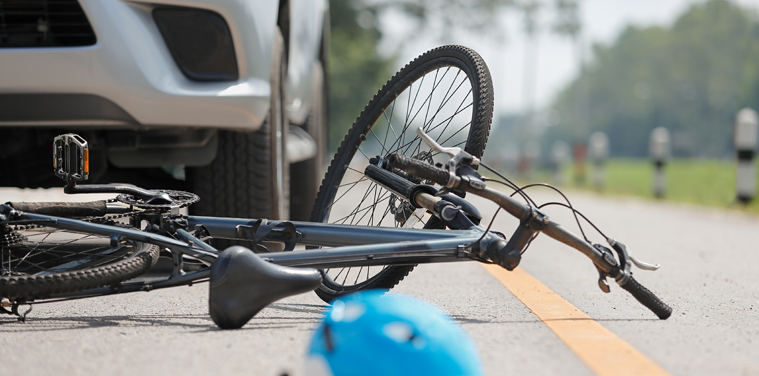Popular Blogs

Riding a bicycle is risky when taking on roads with other vehicles. While automobiles such as cars, trucks, and vans have metal shielding and airbags protecting drivers, bicyclists only have a helmet and a bunch of knees and elbow pads to protect them from injuries when in an accident. You may understand this and take the necessary caution and safety measures to protect yourself and the people around them. However, the odds are stacked against you, with motor vehicles far outnumbering bicycles in the US. According to Injury Facts, a total of 1024 people lost their lives in bicycle accidents while 424,350 suffered from severe injuries[1].
With the probability of you or a companion bicyclist being in an accident being high, having an understanding of what needs to be done in the immediate aftermath of the accident can make a significant difference. Taking the right steps after the accident will ensure you and your rights are protected, and the liable party is punished for their wrongdoing. Here is what you should do if you find yourself in a bicycle crash:
The first and most important thing to do is to get yourself out of harm’s way. If the accident took place in the middle of the road, move onto a safe spot on the side of the road if you can. If you have been injured and cannot move, ask someone for assistance and get yourself to a safe spot. When you have reached a safe place, sit down and assess your body to ascertain whether you have suffered any injuries.

After you are in a safe place, look out for any injuries you may have sustained. Likely, you do not feel pain right after the accident and downplay the extent of your injuries. This is due to the adrenaline rush that is induced by the shock of being in an accident. So you should call 911 if you crashed with a motor vehicle. Do this irrespective of how you feel. If you see blood, feel pain, or a part of your body feels numb, request for an ambulance on the call. Doing so is crucial as the first responders will give you the expert medical assistance you require and record the information about your injuries that could become a key source of information you may require for your claim in the future.
Stay on the scene even if you have not sustained any severe injuries. The symptoms of your injury may show up after hours or even weeks. Wait for the police to arrive and stay at the scene until a report is filed. Leaving the scene can be used against you, and the at-fault driver may never be identified.
Don’t interact with the driver or make any negotiations with them. Many motorists may accept their fault in the beginning but deny even being present at the scene later. Rather wait for the police to arrive and let them document everything in their report. Upon arriving and analyzing the accident scene, the police may ticket the driver. This may come in handy when you go for settling the case with the driver’s insurance company.
Some police officers tend to ignore the cyclists and only record the motorist’s statement. Ensure you get your side of the story documented in the police report. Make sure to report all the injuries you have sustained, irrespective of how minor they are. If the officer denies recording your statement despite your best efforts, you can get the report amended. Also, remember to ask for the reporting police officer’s name and badge number, as it may come in handy when you go to get the report amended.
Try and collect the motorist’s name, contact number, address, driver’s license details, vehicle number, and insurance information. Besides this, try and gather the name and contact information of the people who witnessed the accident. This information may or may not be included in the police report and can prove crucial when settling the case or taking your accident claim to court.
Take a note of the chain of events as it happened in your mind, on your phone, or on a piece of paper if available. Ensure you note down the accident location, the time, the weather conditions, the state of the traffic, and the sequence of events as they occurred. It is human tendency and nature to forget traumatic events, and the notes will help you remember the sequence of events as they occurred.
Try and collect as much evidence as possible. Take pictures of the accident scene, the vehicle involved, the damage done to your bicycle, and the injuries you sustain. Besides this, preserve the evidence you can. Do not get your bike or other property fixed after the accident, keep your dirty clothing as it is, and preserve the other biking equipment damaged in the accident. The evidence will help you prove your claim in front of the insurance company and get fair compensation for the damages you incurred
Right after the accident, go for a thorough medical check-up. Get yourself thoroughly evaluated by a practitioner and document the medical records. Make sure you get pictures of your injuries taken after the accident as soon as possible. Start a medical journal to note down the symptoms you experience after the accident.
Bicycle accidents with motor vehicles involve various legal issues that might be difficult for you to comprehend. Besides this, you will be pressured by the motorist’s insurance company to settle the case as quickly as possible. Almost every insurer tries to aggressively settle the case and offers a significantly low compensation than the plaintiff deserves. Consulting a seasoned bicycle accident attorney will be in your best interests as the lawyer will help you evaluate the value of your claim, deal with the insurance company, handle the paperwork, and represent you in a trial if necessary.